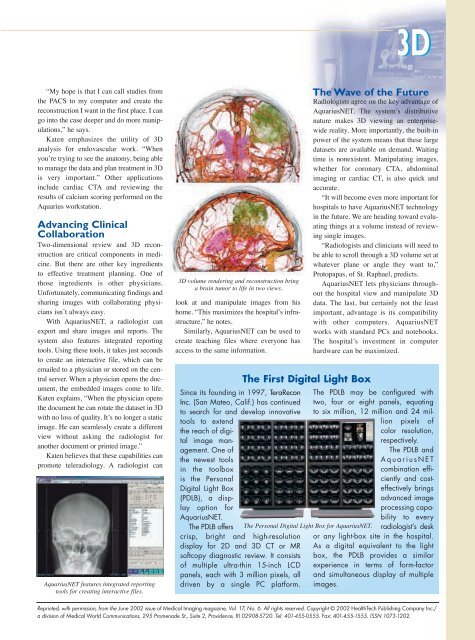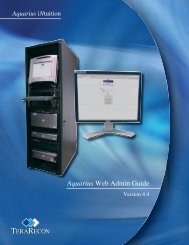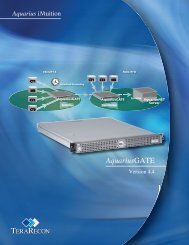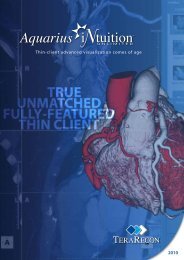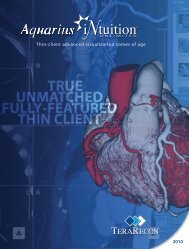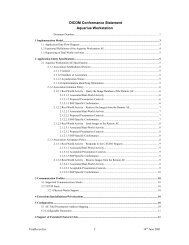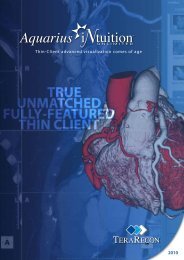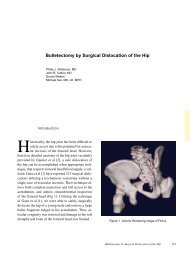NUCLEAR MEDICINE
3D - TeraRecon
3D - TeraRecon
- No tags were found...
Create successful ePaper yourself
Turn your PDF publications into a flip-book with our unique Google optimized e-Paper software.
3D<br />
“My hope is that I can call studies from<br />
the PACS to my computer and create the<br />
reconstruction I want in the first place. I can<br />
go into the case deeper and do more manipulations,”<br />
he says.<br />
Katen emphasizes the utility of 3D<br />
analysis for endovascular work. “When<br />
you’re trying to see the anatomy, being able<br />
to manage the data and plan treatment in 3D<br />
is very important.” Other applications<br />
include cardiac CTA and reviewing the<br />
results of calcium scoring performed on the<br />
Aquarius workstation.<br />
Advancing Clinical<br />
Collaboration<br />
Two-dimensional review and 3D reconstruction<br />
are critical components in medicine.<br />
But there are other key ingredients<br />
to effective treatment planning. One of<br />
those ingredients is other physicians.<br />
Unfortunately, communicating findings and<br />
sharing images with collaborating physicians<br />
isn’t always easy.<br />
With AquariusNET, a radiologist can<br />
export and share images and reports. The<br />
system also features integrated reporting<br />
tools. Using these tools, it takes just seconds<br />
to create an interactive file, which can be<br />
emailed to a physician or stored on the central<br />
server. When a physician opens the document,<br />
the embedded images come to life.<br />
Katen explains, “When the physician opens<br />
the document he can rotate the dataset in 3D<br />
with no loss of quality. It’s no longer a static<br />
image. He can seamlessly create a different<br />
view without asking the radiologist for<br />
another document or printed image.”<br />
Katen believes that these capabilities can<br />
promote teleradiology. A radiologist can<br />
AquariusNETfeatures integrated reporting<br />
tools for creating interactive files.<br />
3D volume rendering and reconstruction bring<br />
a brain tumor to life in two views.<br />
look at and manipulate images from his<br />
home. “This maximizes the hospital’s infrastructure,”<br />
he notes.<br />
Similarly, AquariusNET can be used to<br />
create teaching files where everyone has<br />
access to the same information.<br />
Since its founding in 1997, TeraRecon<br />
Inc. (San Mateo, Calif.) has continued<br />
to search for and develop innovative<br />
tools to extend<br />
the reach of digital<br />
image management.<br />
One of<br />
the newest tools<br />
in the toolbox<br />
is the Personal<br />
Digital Light Box<br />
(PDLB), a display<br />
option for<br />
AquariusNET.<br />
The PDLB offers<br />
crisp, bright and high-resolution<br />
display for 2D and 3D CT or MR<br />
softcopy diagnostic review. It consists<br />
of multiple ultra-thin 15-inch LCD<br />
panels, each with 3 million pixels, all<br />
driven by a single PC platform.<br />
The Wave of the Future<br />
The First Digital Light Box<br />
The Personal Digital Light Box for AquariusNET.<br />
Radiologists agree on the key advantage of<br />
AquariusNET. The system’s distributive<br />
nature makes 3D viewing an enterprisewide<br />
reality. More importantly, the built-in<br />
power of the system means that these large<br />
datasets are available on demand. Waiting<br />
time is nonexistent. Manipulating images,<br />
whether for coronary CTA, abdominal<br />
imaging or cardiac CT, is also quick and<br />
accurate.<br />
“It will become even more important for<br />
hospitals to have AquariusNET technology<br />
in the future. We are heading toward evaluating<br />
things at a volume instead of reviewing<br />
single images.<br />
“Radiologists and clinicians will need to<br />
be able to scroll through a 3D volume set at<br />
whatever plane or angle they want to,”<br />
Protopapas, of St. Raphael, predicts.<br />
AquariusNET lets physicians throughout<br />
the hospital view and manipulate 3D<br />
data. The last, but certainly not the least<br />
important, advantage is its compatibility<br />
with other computers. AquariusNET<br />
works with standard PCs and notebooks.<br />
The hospital’s investment in computer<br />
hardware can be maximized.<br />
The PDLB may be configured with<br />
two, four or eight panels, equating<br />
to six million, 12 million and 24 million<br />
pixels of<br />
color resolution,<br />
respectively.<br />
The PDLB and<br />
AquariusNET<br />
combination efficiently<br />
and costeffectively<br />
brings<br />
advanced image<br />
processing capability<br />
to every<br />
radiologist’s desk<br />
or any light-box site in the hospital.<br />
As a digital equivalent to the light<br />
box, the PDLB provides a similar<br />
experience in terms of form-factor<br />
and simultaneous display of multiple<br />
images.<br />
Reprinted, with permission, from the June 2002 issue of Medical Imaging magazine, Vol. 17, No. 6. All rights reserved. Copyright © 2002 HealthTech Publishing Company Inc./<br />
a division of Medical World Communications, 295 Promenade St., Suite 2, Providence, RI 02908-5720. Tel: 401-455-0555. Fax: 401-455-1555. ISSN 1073-1202.


